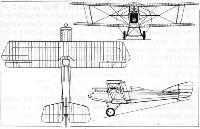
Martinsyde. Серия F
Выпуск данной серии начался с самолета Martinsyde F.1, большого двухместного биплана с размещением членов экипажа тандемом в открытой кабине. Самолет предполагалось использовать как истребитель, но летчика разместили в задней кабине, а наблюдателя - в передней. В результате наблюдатель закрывал летчику обзор и мешал прицеливанию при ведении огня из фиксированных пулеметов, а летчик сокращал сектор стрельбы из турельного пулемета наблюдателя. Построили всего два F.1, каждый с мотором Rolls-Royce мощностью 250 л. с. Судьба самолета была очевидной еще до начала официальных испытаний, вооружение на эти F.1 не ставилось.
Следующим в данной серии стал единственный экземпляр самолета F.2. Это был более компактный по сравнению с F.1 двухместный биплан с 200-сильным мотором Hispano-Suiza. Самолет выдержал летные испытания, но в серию не передавался. Летчик на F.2 размещался перед наблюдателем, что логично, но и тут обзор летчику был сильно ограничен стойками и центропланами верхнего и нижнего крыльев.
<...>
Описание:
- Martinsyde. Серия F
- Flight, June 1920
THE MARTINSYDE MACHINES
Фотографии
-
Flight 1920-06 / Flight
The Martinsyde R.G., 190 h.p. Rolls-Royce engine
-
Flight 1920-06 / Flight
Регистрационный номер: A3933 [3] The Martinsyde F.1, 250 h.p. Rolls-Royce engine
-
Мировая Авиация 185
Регистрационный номер: A3933 [3] На Martinsyde F.1 летчик сидел за наблюдателем, такое размещение членов экипажа сложно назвать удачным.
The sole prototype Martinsyde F.1 two-seat fighter -
Aeroplane Monthly 1995-08 / Personal album. Military
Регистрационный номер: A3933 [3] While efforts are made to start the RAF 4A engine of B.E.12a A697, Martinsyde F.1 A3933 takes off. The B.E.12a has no Vickers gun in place, but there is an elevated Strange-type mounting for a Lewis gun ahead of the cockpit. A597 was struck off charge on July 21, 1918.
Другие самолёты на фотографии: RAF B.E.12 - Великобритания - 1916
-
Flight 1920-06 / Flight
The Martinsyde F.2, 200 h.p. Hispano-Suiza engine
-
Air International 1985-12 / Fighter A to Z
The prototype F.2 which entered flight test before the F.1.
-
Air International 1985-11 / Fighter A to Z
The Martinsyde R.G. which, in some respects, was an evolutionary development of the Elephant and was discontinued in favour of the F.3 Buzzard.
- Фотографии






